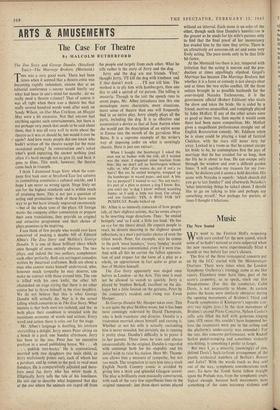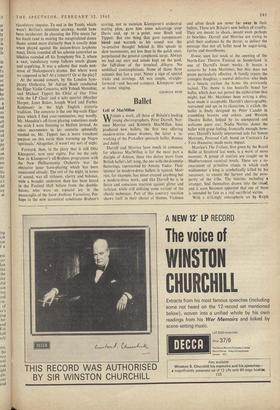Music
The New Sound
WE went to the Festival Hall's reopening with ears cocked for the new sound, which some of us hadn't noticed or even suipected when the new resonators were experimentally fitted a month or two before last year's closure.
The first of the three reinaugural concerts put on by the LCC started with the Meistersinger Overture. There were times when the London Symphony Orchestra's trumps came at me like razors. Elsewhere inner horn lines, part of the score's carpentry, so to speak, stuck out like Hauptstimme. (For this the conductor, Colin Davis, is not necessarily to blame. At certain points the horns were similarly obtrusive during the opening movements of Brahms's Third and Fourth symphonies at Klemperer's supreme con- cert two nights later.) In the slow movement of Brahms's second Piano Concerto, Nelson Cooke's cello solo filled the hall with generous singing tone. (I'll swear this couldn't have happened be- fore the resonators were put in the ceiling and the platform's under-cavity was extended.) For the rest, this concerto performance, with Rudolf Serkin pedal-stomping and sometimes violently mis-hitting, is something I prefer to forget.
But may L.as a minority (seemingly) of one, defend Davis's back-to-front arrangement of the purely orchestral numbers of BerliOz's Romeo and Juliet? With the words (such as they are) out of the way, symphonic considerations took over. To have the Tomb Scene follow straight upon the Prelude was, from the symphonic angle, logical enough, because both movements have something of the same tearaway violence and ,ejaculatory impulse. To end in the Tomb, which wasn't Berlioz's intention anyway, would have been incoherent. In choosing the Fête music for• his finale (and in making the recapitulated dance theme sound more distinctly than it usually does when played against the unison-brass larghetto tune), Davis rounded off his scheme somewhat as Sibelius rounded off his Symphony No. 2, where a vast, valedictory romp follows much gloom and argufying. It was a scheme that made non- sense of Shakespeare's drama. But where were we supposed to be? At a concert? Or at the play?
At the second concert, by the London Sym- phony Orchestra, Sir Adrian Boult conducted the Elgar Violin Concerto, with Yehudi Menuhin; and Michael Tippett his Child of Our Time with the LP Choir and a solo quartet (Heather Harper, Janet Baker, Joseph Ward and Forbes Robinson) in the high English oratorio tradition. The concerto is the one big-scale Elgar piece which I find pver-ruminative, nay woolly. Mr. Menuhin's off-form playing sometimes made me wish I were listening to Heifetz instead. As other movements in his oratorio splendidly remind us, Mr. Tippett has a more trenchant purpose on this earth than warming up Negro 'spirituals.' Altogether, it wasn't my sort of night.
Forward, then, to the glory that is still Otto Klemperer, now near eighty. For me the only flaw in Klemperer's all-Brahms programme with the New Philharmonia Orchestra was the obtrusive inner horn-playing which has been mentioned already. The rest of the night, in terms of sound, was all richness, clarity and balance, With a broader undertow than has been heard in the Festival Hall before from the double- basses, who were an especial joy in the Passacaglia of the Saint Anthony Variations. Per- haps in the new acoustical conditions Brahms's scoring, not to mention Klemperer's orchestral seating plan, gave him some advantage over Davis and, up to a point, over Boult and Tippett. But one thing that gave Conspicuous blend and warmth to his sound was the 're-creative thought' behind it. His speeds in slow movements, not less than in the quick ones, perpetuated the general symphonic surge. Always we had our ears and minds kept on the goal, the full-close of the terminal Allegro. No umbilical contemplations. None of those three minutes that last a year. Never a sign of special tricks and strivings. All was simple, straight- forward—and beyond compare. Klemperer sent us home singing.
ClIARLEs REID


































 Previous page
Previous page